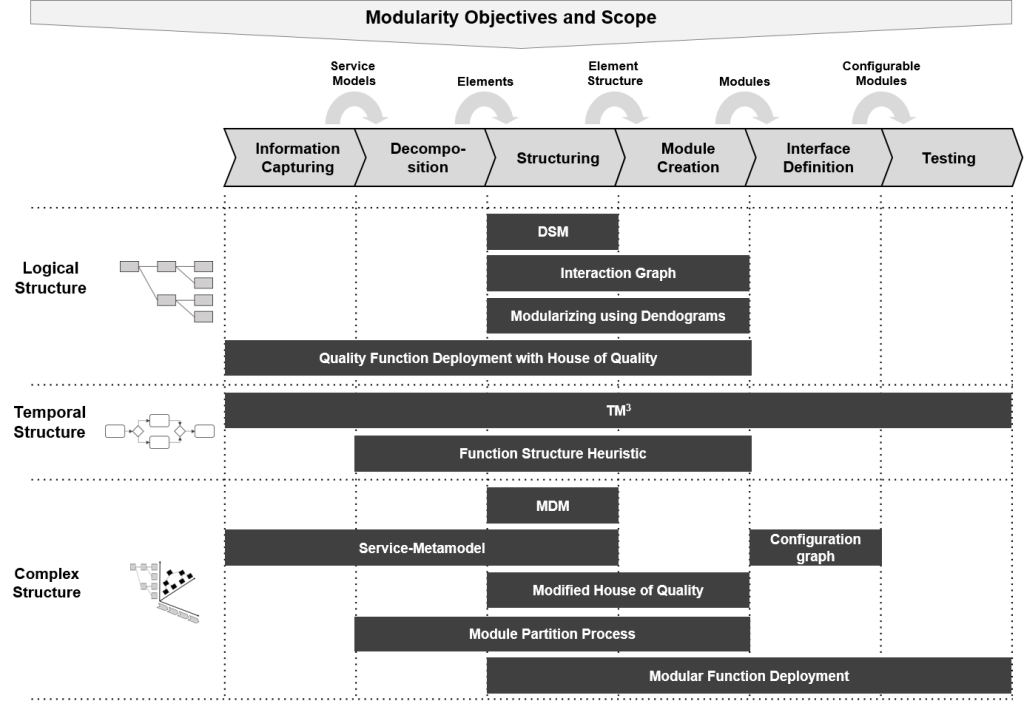As of now, several methods for modularization of products and services can be found in the academic literature. These methods can be classified using a framework with two dimensiona, as introduced by Lubarski and Pöppelbuß (2016). The first dimension describes the transformation process towards a modular service architecture. The second dimension presents the general structure of the result. Both the transformation process and the result of the modularization initiative of the company (i.e., configurable modular service architecture) are influenced by the desired scope of modularity and modularity objectives, which provide an overarching framing.

The systematization framework refers to the scope of modularity and modularity objectives, which influence the progress and the results of initiatives for service modularization in companies and organizations.
- The modularization objectives can be differentiated in two superior goals and the corresponding modularization strategies. On the one hand, there is the efficiency driven modularization facing the offer of multi-variant services combined witch cost reduction, using better resource utilization. On the other hand, an additional goal is a marked oriented variety management that faces the exhaustion of non-reached market potentials.
- Concerning the scope of modularity, a differentiation is needed. We need to differentiate between the part and the scope of the service portfolio of the organization, which involves the modularization initiative. Firstly, the modularization should enable synergies, which are beyond the scope of limits existing services offerings. Simultaneously it could be essential and useful to focus on specific urgent or promising segments to increase the feasibility and the probability of success of the modularization efforts.
The first dimension of the methodical landscape differentiates in various phases, which are passed through the modularization initiatives of services offerings. Beginning with the collection of information about the existing service portfolio and/or customer needs, those phases cover also the testing of the modular building kit and the definition of modules as well as rules and interfaces for modular combination.
- The process of collecting information serves as the assessment of the current situation. It includes the analysis of the status quo for the purpose of the existing service offering and the service delivery processes. It also includes the identification of the customer needs for different services varieties.
- The second phase is called “Decomposition”. It attends to the breakdown of the previously collected information in their element on a detailed consideration level. The results of the decomposition are the smallest possible logical units, which could be used for the development of modules. The serevices are divided in their components into an object list, e.g. car inspection will be divided in oil change, safety check and filter change. Processes are disassembled in sub processes or sub activities.
- The “Structuring” phase sorts the previously identified elements using one or more description dimensions to show relations between those elements. Those relations are shown in an array to present connection- and interaction strengths. The relations match various classes by given attributes (e.g. automated activity vs. manual activity, use of certain resources, customer contact: Yes or No). The result is an element structure, for example an array or classification.
- The module generation phase continues with the generated element structure. It targets the joining of elements, which show a strong relation or strong interactions to form modules with a high inner coherence. Accordingly to the idea of modularization, the generated modules should be as independent as possible from each other.
- The next stage is the definition of modular relationships. In this stage, the configuration possibilities for the service bundles are determined, based on the previously generated modules. Placeholder could be defined for the selection between different modular alternatives. Specific modules can exclude or require each other. In this stage interfaces are defined which enable the combination of several modules.
- In the final phase, the modular tool kit is tested. While doing so it is to prove, if the use of these modules leads to useful solutions, while simultaneously to eliminate the undesirable configurations. Furthermore it has to be evaluated, if the modular tool kit provides real improvements in the efficiency of the sales department and in the provision of services.
The second dimension differentiates between several forms of structuralizing for the modules. Logical structures are well known from the manufacturing industry for the construction of products from single components, using e.g. simple object lists. As for the service industry, a temporary structure would be more appropriate, meaning that the modules are placed in a temporary order to each other. This leads to the existence of the so called forerunner-follower-relationships. These first two structural forms could be understood as an analogy to the organizational structure and operational organization. Finally, a complex structure is also possible, in which several logical structures, various temporary structures or logical and temporary structures are combined.
